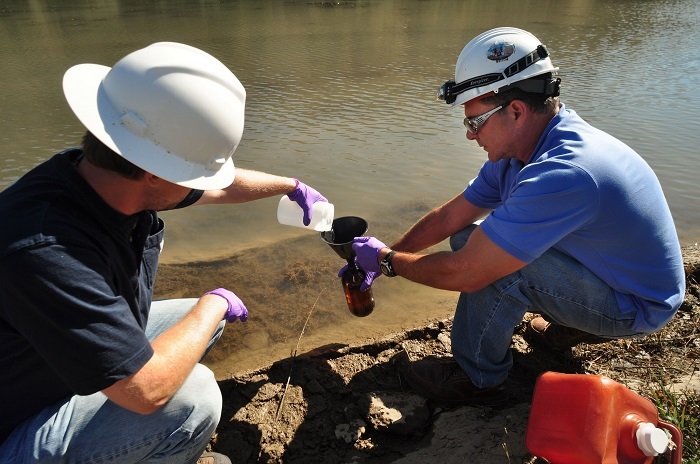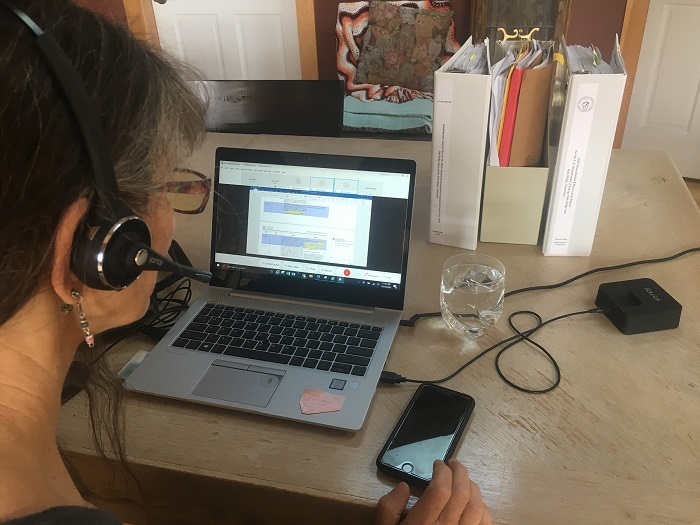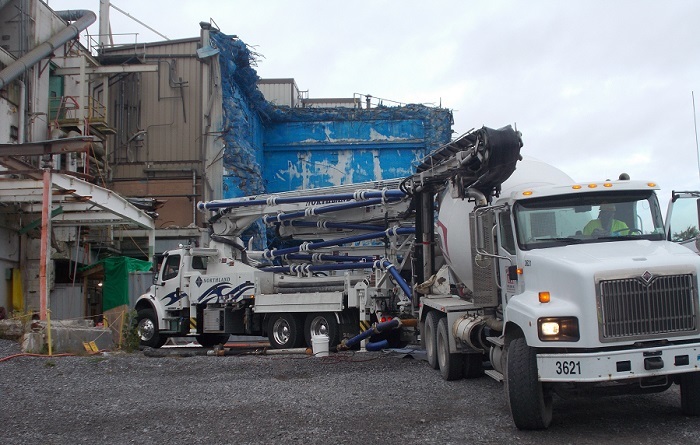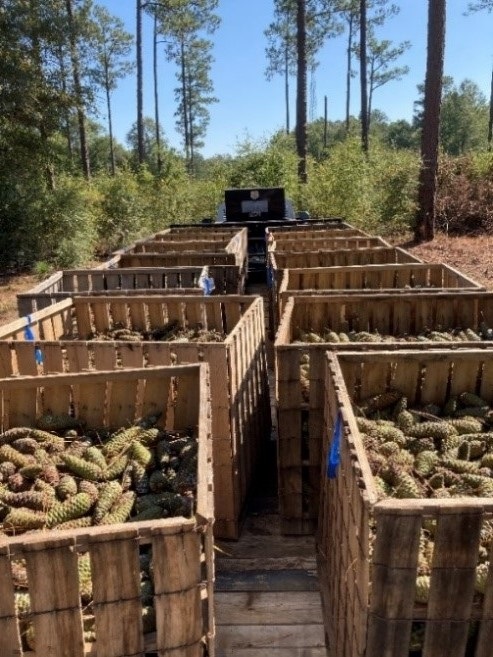 EM regularly conducts sampling across the Oak Ridge Reservation. The five-year review uses groundwater, surface water, soil, sediment, and data from plant and animal life from fiscal 2016 to fiscal 2020 for its evaluations.
OAK RIDGE, Tenn. – DOE’s Oak Ridge Office of Environmental Management (OREM) and its cleanup contractor UCOR are conducting a critical review of remediation measures in place across the Oak Ridge Reservation virtually as they adapt to challenges from the COVID-19 pandemic.
The five-year, multi-agency review underway is designed to determine if remedies that have been implemented continue to protect human health and the environment. Required by CERCLA — the Comprehensive Environmental Response, Compensation and Liability Act — the review covers the three DOE sites in Oak Ridge — the East Tennessee Technology Park, Oak Ridge National Laboratory, and Y-12 National Security Complex. This is the fifth review since the start of remedial actions in Oak Ridge in the 1990s.
The review included more than 40 interviews held this summer followed by virtual site visits in August and September. Those interviewed included facility managers, engineers, system operators, project managers, subject-matter experts, and site personnel. Regulators, stakeholders, members of the Oak Ridge Site Specific Advisory Board, and others participated in the virtual site visits. Interviews and visits were conducted using online conference systems.
 Lynn Sims, the manager of the five-year review, looks at data that will help evaluate Oak Ridge’s remediation measures. Sims is an employee of UCOR subcontractor RSI, which performs water and soil sampling at the site, among other things.
All three Oak Ridge sites will be evaluated on their performance of cleanup remedies. This evaluation will continue into next year, with results scheduled to be delivered by May 31, 2021.
“This is an important review that helps ensure that public health and safety, and the environment are protected over the long term,” OREM Quality and Mission Support Division Director Dave Adler said.
Cleanup remedies address the legacies remaining from more than 50 years of energy research and weapons production. The measures includes environmental remediation, removing deteriorated and radioactively contaminated facilities, and disposing legacy low-level, mixed low-level, transuranic wastes, and hazardous and non-hazardous industrial wastes.
The review, which will be finalized and released next year, uses groundwater, surface water, soil, sediment, and data on plant and animal life from fiscal 2016 through fiscal 2020 as the basis for its evaluations. Sampling is conducted as part of the review.
OREM, UCOR, the U.S. Environmental Protection Agency, and the Tennessee Department of Environment and Conservation will evaluate that data to ensure that the cleanup and remediation that are conducted to fulfill regulatory commitments are protective of human health and the environment.
-Contributor: Mike Butler
 One of 44 trucks delivers grout to the West Valley Demonstration Project to place inside a cell 30 feet below ground.
WEST VALLEY, N.Y. – EM and cleanup contractor CH2M HILL BWXT West Valley (CHBWV) recently began grouting a large underground cell at the West Valley Demonstration Project (WVDP) to provide structural stability for when heavy demolition equipment operates aboveground to tear down the Main Plant Process Building.
The cell, which is nearly 30 feet below ground, will remain in place until the underground portion of the Main Plant Process Building is removed in the future. Crews continue to prepare the building for demolition.
“The WVDP team’s work was well planned and executed in an effort to maintain safety, including the addition of COVID-19 protocols,” EM WVDP Safety and Site Programs Team Leader Jennifer Dundas said. “This work is part of DOE’s efforts to reduce legacy risks in preparation for the future demolition of the Main Plant Process Building, an EM priority for 2020.”
A total of 44 trucks supported the grouting effort. Prior to grouting, all major process equipment was removed, interior surfaces were decontaminated and sealed, all utilities and connections with adjoining structures were disconnected, and characterization data was obtained to plan for future waste disposal.
Before crews deactivated the cell, it had contained radiological and hazardous contaminants resulting from spent nuclear fuel reprocessing activities.
“This work activity was successful because it was a group effort,” said Scott Chase, facility disposition operations manager. “Our crew worked with the engineering division on the overall plan and we had good support from the radiation control and security divisions as well.”
Used in spent nuclear fuel reprocessing operations in the late 1960s and early 1970s, the cell is 46 feet long, 11 feet wide, and nearly 20 feet tall.
-Contributor: Joseph Pillittere
NEW ELLENTON S.C. – U.S. Forest Service employees recently held their annual longleaf pine cone collection event on Savannah River Site (SRS), gathering approximately 700 bushels of pine cones.
The cones will be sent to a facility where the seeds are extracted and planted, and will eventually grow into longleaf pine seedlings at a nursery. Those seedlings will then be used on SRS and by partnering agencies to help restore lands once dominated by longleaf pine forests.
“Collecting cones from known longleaf pine trees that are phenotypically superior ensures great genetic stock. When we replant, we want to know the seedlings will grow well in this area,” Silviculture Forester Jennie Haskell said. “We have had tremendous success planting quality seedlings from locally collected cones as opposed to reforesting with seedlings collected from other zones.”
A silviculture forester manages programs to control the establishment, growth, quality, and health of forests. They analyze forests to maximize timber production and minimize negative impacts on the land, water, and wildlife.
 |
|
Preparing collected cones for transport to the facility where their seeds will be extracted and eventually planted. |
Restoring the longleaf pine community is an important objective for the U.S. Forest Service across the SRS and the southeast region of the U.S. This process takes many years. Reforesting with longleaf pine seedlings is just one step. Prescribed fire, chemical treatments, and harvesting to remove undesirable vegetation and reduce competition are also important in the process.
The longleaf pine community, when maintained with prescribed fire, is one of the most biologically diverse ecosystems in North America. The biodiversity is evident in the abundant understory and groundcover that is important to many wildlife species, including wild turkey, white tail deer, fox, squirrels, many reptiles, numerous songbirds, and native butterflies and other pollinator species.
“Forest management is a long-term ongoing process. We provide sustainable forest products, bioenergy, and economic stability to our local communities. It all starts with collecting the hundreds of seeds contained in each individual pine cone,” Forest Planner David Malone said.
To learn more about ongoing forest restoration efforts on SRS, click here. -Contributor: Joe Orosz
|